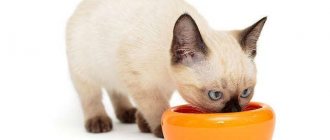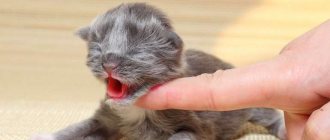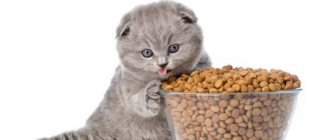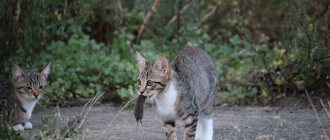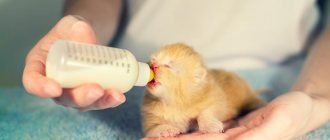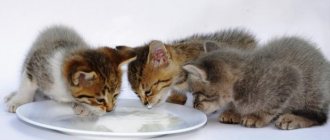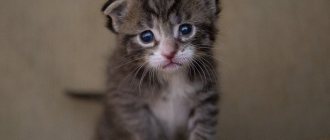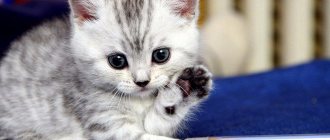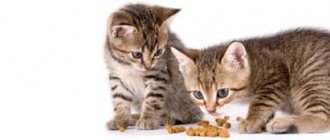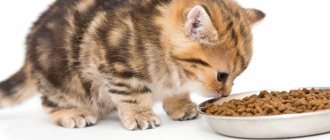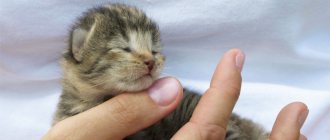There is nothing more nutritious and beneficial for a child’s body than mother’s milk. Despite this fact, some circumstances oblige the owner to look for alternative feeding methods. He has to find out on his own what and how many times he can feed a kitten at 1 month, so as not to harm the baby. By following the rules for introducing complementary foods and excluding prohibited foods, you can easily raise a healthy and strong pet on your own.
Features of feeding a one-month-old kitten
The diet of a 1-month-old kitten depends on the presence of a mother cat. The longer they live together, the later complementary foods are introduced.
If there is a mother cat
On average, breastfeeding continues until two or even three months of age, which makes caring for the baby very easy. Colostrum secreted in the first days after birth is of particular value. Together with it, newborns receive passive immunity, protecting against infections until the first vaccination.
In addition to feeding, the mother cat takes care of the comfortable digestion of her cubs. To do this, she rubs her paws on their tummies after each meal or licks them. This massage makes it easier to go to the toilet, preventing constipation.
If the baby is taken away from his mother
You should not separate the baby from its mother until 1.5 months. If the mustachioed nurse does not have milk, died, or you simply picked up a tiny animal right on the street, try to find him a “foster mother.” This option is the most reliable, but rarely implemented.
If you couldn’t find a new nurse, then you will have to feed your one-month-old baby yourself. Special milk formulas (Gimpet, Beaphar, Royal) from veterinary pharmacies and pet stores will help with this. Their composition is as close as possible to mother's cat milk, so kittens quickly learn to drink directly from a bowl. It is better to give newborns a drink from a pipette, syringe or bottle with a nipple.
Cow's and goat's milk are only suitable as an emergency option before purchasing formula. They do not contain the necessary nutrients, and their constant consumption is fraught with intestinal upset.
Breed differences
The nutrition of a 1 month old kitten practically does not depend on the breed. At this age, he needs a high-calorie diet rich in calcium. It promotes proper growth and the formation of a strong skeleton.
The differences can be seen a little later, after 1.5-2 months:
- British
. Frequent consumption of carrots, kelp and liver changes the blue color. The daily menu should consist of 65% meat products and 25% vegetables. High protein content is essential for these stocky cats, who are characterized by rapid growth and weight gain.
- Scottish folds
. A high-calorie diet has a beneficial effect on the quality of the fur coat. Due to the innate tendency to allergies and urolithiasis, avoid purchasing economy-class food.
- Sphinxes
. Representatives of hairless breeds are characterized by increased appetite and poor intelligibility. They often suffer from obesity and gastrointestinal problems. It is better to feed them strictly by the hour, never exceeding the recommended norms.
Owners of purebred animals should pay attention to ready-made industrial feed. Many manufacturers offer specialized lines focused on the characteristics of specific breeds.
Making your own nutritional mixtures for kittens at home
Despite all the advantages of the products described above, they have their drawbacks. The main one is low availability, since not in every city the owner can find what he needs (not to mention small towns). In such cases, you have to make formulas for feeding at home.
True, veterinarians and experienced breeders warn that it is impossible to achieve the ideal ratio of all nutrients and vitamins in this case. But as a temporary option, this is an excellent solution.
Scott's formula for feeding kittens
The quantities of the following ingredients are given for each half kilogram of weight. Accordingly, for a pet weighing 250 grams, these doses should be divided in half.
Scott's mixture is prepared from the following products:
- 25 gr. whole cow's milk (low-fat).
- Requires 7.5 g. powdered milk.
- 1.5 gr. dry baker's yeast.
- 25 gr. egg powder or whole egg.
- It also requires 25 gr. whipped egg whites.
- 0.5 gr. sunflower or olive oil (refined).
- 2 gr. glucose or sugar.
The components of the mixture are thoroughly mixed in a mixer. Before use, the product is heated to 37°-38° Celsius.
Tailinga mixture – fortified mixture
It is believed that the Tailing mixture is healthier, since it contains more vitamins and microelements. The product is prepared from the following components (as in the previous case, for every half a kilogram of live weight):
- Requires 25 gr. whole milk.
- Powdered milk – 5 g.
- Glucose or sugar – 2 gr.
- Vitamins for kittens – one gram. Of course, before purchasing vitamins, you should definitely consult a veterinarian!
All ingredients must be mixed thoroughly. The mixture is also used heated to 37°-38° Celsius.
Rules for introducing complementary foods
The little pet begins to be fed from 4-8 weeks, gradually diluting the milk menu with more solid products. When introducing complementary foods, follow these rules:
- Puree your meals and focus on carbohydrates and calcium. Cook milk porridges and use a limited amount of meat until baby teeth erupt.
- Add new dishes at intervals of 2-3 days to track the body's reaction. This will help identify allergies and food intolerances.
- Offer to try unfamiliar food straight from your finger. After approval, it can be poured or transferred to a bowl.
- Consider your pet's tastes. If the cat refuses the food offered, you should not force feed it. Thanks to the variety of possible options, the diet can be chosen to suit every taste.
- Avoid food that is too hot or cold. Temperatures above and below room temperature can injure mucous membranes.
- Don't leave uneaten food for later. To avoid indigestion and poisoning, serve only fresh food.
- Try to eliminate sources of noise while eating. Without being distracted by irritants, the baby will focus more on food and quickly learn to eat on his own.
- Avoid overfeeding. Not all babies feel full. It is safer to feed them often, but in small portions.
You can determine the time of introducing complementary foods in the presence of a mother cat by changing her behavior. By 4-6 weeks after birth, her milk supply decreases, so she increasingly leaves the “nest”. With the developed maternal instinct, the pet begins to take the cubs to the kitchen, showing them bowls of food. By repeating after their mother, babies quickly learn to eat on their own.
What foods to give your baby
Proper and balanced nutrition eliminates stunting and other developmental problems. The owner will have to decide in advance what his kittens will eat at 1 month. Mixing “natural” and “drying” negatively affects digestion, causing coprostasis, gastroenteritis and other complications. For your pet’s health, you need to choose only one type of feeding and stick to it for the rest of your life.
Natural food
Feeding “natural” food is much more difficult than dry food. In addition to daily cooking, you will have to take care of purchasing vitamins, since it is almost impossible to reach the norm with food alone. You can feed your little pet:
- boiled quail or chicken yolk;
- minced meat and broth;
- semolina or rice porridge;
- vegetable puree from cabbage, zucchini and pumpkin;
- low-fat kefir, cottage cheese and yogurt.
As an alternative food, you can choose wet and dry food. Any brands of at least premium class, designed for cats under 1 year of age, are allowed.
Wet food
Until the teeth appear, you will have to limit yourself to canned pates. Later you can switch to meat pieces in jelly. These feeds are almost 80% water. They require much less liquid to digest than dry kibble.
Don't pack too big in hopes of saving money. Opened food quickly becomes unusable, so the cat may not have time to eat it before the expiration date.
Dry food
Dry food is good for preventing tartar and is enriched with all necessary vitamins. In addition to the class, you need to pay attention to the manufacturer. Veterinarians do not recommend frequent changes of brands and try not to go beyond a certain brand, even with a therapeutic diet.
At first, it is better to soak the granules in warm water. In this case, even a toothless pet can eat them. When choosing dry food, it is especially important to comply with the water consumption rate. Calculate how much liquid your pet drinks per day and adjust the amount if necessary.
Do I need to continue formula feeding?
Use formulas until the baby is two months old, until he gets used to solid food and begins to eat on his own. After all baby teeth appear, adjust the diet in favor of an adult.
Dry food – helper or enemy?
There is still fierce debate about whether feeding kittens dry food is beneficial. On the one hand, such food really exists and can provide the kitten with the necessary nutrients. At the same time, a kitten accustomed to Hills or Whiskas will subsequently be very difficult to switch to regular food.
There is also a more compelling reason to temporarily abandon dry food in the diet of a four-legged baby in the first month of his life. Generally safe for an adult animal, they can “give” a kitten indigestion, constipation, and serve as the onset of urolithiasis. And, ultimately, significantly shorten the animal’s lifespan.
Whatever you choose to feed a grown cat, it is better to feed the cub with healthy, balanced food, with plenty of milk and meat porridge. Take care of the health of your four-legged happiness so that he will delight you with his purring for as long as possible!
What else to see:
Forbidden food
Do not forget that any food from the human table is contraindicated for pets. Stop any attempts by compassionate relatives to feed your “unlucky” pet pickles, sweets, herbs, smoked meats, flour, fried and fatty foods. A moment's pleasure can turn into a long and expensive treatment.
In addition to the foods listed, avoid feeding:
- pearl barley and millet;
- sorrel, onion and garlic;
- any bones;
- pork;
- mushrooms and potatoes;
- raisins and grapes;
- legumes
Don't believe the myths about the benefits of milk and fish. After a year, cats develop lactose intolerance, accompanied by diarrhea and increased gas production. Fish is fraught with the development of urolithiasis and kidney inflammation, so it is also better to avoid its frequent consumption.
The first month of a pet's life
When buying a one-month-old kitten, remember: this is an important and responsible act. How you care for and feed the animal at an early age determines its immunity in the future. A strong immune system is the key to health. Of course, genes play a significant role in this matter, but diet and food are also important. The main rule is no food from the common table. Remember: the digestive system of animals is completely different from that of humans. There is no need to give the kitten whole milk, sour cream, sweets and other products.
A one-month-old kitten needs:
- Completely exclude contact with other animals, even if they are pets and have vaccinations.
- Don't let them go out into the yard to avoid picking up fleas, worms and various infections.
- Try to remove shoes and clothes that a person wears on the street.
All these recommendations will contribute to the development of good immunity in the animal.
Getting your kitten used to solid food
With the appearance of baby teeth, you can diversify your diet with solid foods. Instead of minced meat, offer your pet finely chopped meat and fish pieces. Use only low-fat varieties, not forgetting about pre-freezing and cooking. Two-stage treatment at different temperatures will eliminate infection by parasites.
Gradually reduce the amount of liquid in porridges by adding meat to them. The baby quickly gets used to this additive in broths and cereals, but you will have to tinker with the individual serving of meat. If the pieces remain in the bowl, then try grinding them into minced meat and offering them again. Having become accustomed to the smell and taste, the cat will begin to eat meat in larger quantities.
Feeding frequency and portion size
When feeding “dry”, it is enough to focus on the norms indicated on the packaging. By weighing your pet, you can easily find out its daily portion.
The frequency of feeding depends only on age, so it is the same for pets with different types of nutrition. The recommended number of meals and portion sizes on natural food can be found in the table.
| Age | Feeding frequency (once a day) | Daily serving size |
| Up to 2 weeks | 10, including night time | 30 ml per 100 g weight |
| 2-3 weeks | 9, including night time | 40-45 ml per 100 g weight |
| 3-4 weeks | 8, including night time | 50-55 ml per 100 g weight |
| 1-2 months | 7 | 120 g |
| 2-3 months | 6 | 150 g |
From three months of age, the portion size is increased to 200 g per 1 kg of weight, and the number of meals is reduced to 5. From this moment until six months, the animal enters the most active growth phase. At this time, veterinarians recommend taking into account the individual characteristics of the pets and monitoring their well-being by checking their indicators in the clinic. If you deviate from the norm typical for your pet's breed, you may need to increase or reduce the usual portions.
If you are often away from work, make sure that your friends, relatives or neighbors feed the kitten. Eating too infrequently can lead to overeating or exhaustion. After six months, your pet can be safely switched to three meals a day, and closer to a year - to two meals a day.
Basics of proper nutrition
When deciding how to feed a one-month-old kitten, you need to decide whether in the future it will eat ready-made factory feed or natural food. The pros and cons of both feeding options have been controversial for a long time. Mixing both types of feeding is not recommended. And there are objective reasons for this: different types of food are digested in different ways and for different amounts of time. An animal eating dry food needs more water.
It may not be easy to immediately choose the right nutrition among commercial feeds: ready-made feeds can differ greatly in composition. It is not recommended to mix food of different brands, as this can cause an oversaturation of the body with microelements and vitamins. The consequences of poor nutrition can be serious problems with digestion and gastrointestinal tract.
Even having decided on the option of feeding the baby, there are a number of rules that are important to follow:
- Feeding a one-month-old kitten should be divided into 6-8 servings. At the same time, you need to make sure that your pet does not overeat. The serving size should take into account the food option (natural or dry), as well as the breed and future size of the adult.
- New foods are introduced into the diet separately and gradually. Monitor your cat's reaction to each new product introduced. If problems with digestion or stool occur, the introduction of this product should be postponed.
- If you are feeding natural foods, you may need to add vitamins to your diet. But it is still recommended to consult a veterinarian first.
- And the most important rule is that the chosen feeding option must be of high quality.
